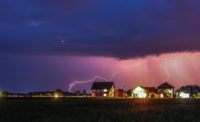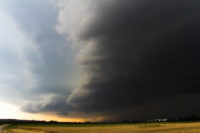5 Ways for Roofing Contractors to Succeed During Storm Season

As contractors, you know storm season brings many challenges from staffing the sheer volume of work to keeping teams organized and on the same page when storms hit.
With storm season underway, here are five best practices that you, as roofing contractors, can bring into your business almost immediately to help you and your team have a successful storm season.
1. Use Technology
Bringing technology into your business will increase your efficiency and give you the ability to work anytime, anywhere, helping you provide the best customer service possible. While there are probably endless benefits to the technology available in our industry today, here are two ways technology can make doing business easier:
• Improve Safety
Tech tools bring project enhancements from inside the office out to the field while helping crews finish jobs safely and on time. Safety becomes even more important when you consider the industry’s labor challenge. Here are some ways tech can help you work faster, safer and smarter:
- Aerial Imaging: Drones and visual mapping systems offer detailed specs of homes before you hit the jobsite, keeping your team away from dangerous positions and saving you manpower for other jobs on site.
- Infrared Cameras: Identify building vulnerabilities and potential problems before you enter a structure to save you from safety hazards and your customers from financial surprises.
• Streamline Project Management
Online project management also allows contractors to conduct all facets of their business — from lead generation to customer estimates — anytime, anywhere. And since storm season is usually the busiest time of the year for your team, being able to manage projects quickly and swiftly is key to success.
- Delivery Notifications: With supplier delivery notifications, you’ll know that you’ve received the correct product for a job before it starts, ensuring you meet project deadlines and manage customer expectations.
- Team Communication: Mobile apps and devices help teams stay connected and updated 24/7, increasing overall production, which is even more crucial while your team is in the throes of working storm projects. Whether in the truck, on a jobsite or at the office, your team can share project and status updates.
- Knowledge Hubs: Project management software brings all your project files into one place, making every document, photo and/or video for a job available to your entire crew, around the clock. This also decreases the amount of space needed to store paper files in the office and the time needed to manage those files.
2. Build Customers’ Trust
Build trust with customers by taking the time to understand their needs and make suggestions around solving their pain points, which will help you establish yourself as a reliable expert and partner.
• Be Active in Your Community Before a Storm
Become familiar with local homeowners by having an active community presence before storm season hits through activities such as volunteering and fundraising. This way when the storm hits, they’ll already know who you are, making them feel more comfortable from the start.
Even after the storm hits, you can show you’re invested in your community by volunteering for storm cleanup efforts or repairs, or by participating in food and supply drives for affected homeowners. Having extra traps or plywood handy to help homeowners with temporary repairs is always a good idea, too.
• Ask and Educate
By being curious about customer needs, homeowners will see you as a trusted partner rather than someone trying to sell them something. Asking thoughtful questions will get you the info you need for successful projects.
Remember to highlight what makes your business different from other contractors in the area.
• Be Honest
In any industry, it’s important to be honest with customers about all facets of their projects. If any project challenges arise, such as going over budget, it’s best to be transparent and have those conversations sooner rather than later.
If you’re worried about having that conversation right away, remember it will be much harder if customers find out you could have told them sooner.
3. Keep Up With Trending Materials
Being aware of trending materials throughout the storm season will help you make sound recommendations to potential customers and show them that you’ll be a smart, focused partner from the start.
• Join Professional Organizations
Professional organizations don’t just share information on their websites and in newsletters. Many participate in conferences and trade shows, including the International Roofing Expo and the International Builders Show, which focus a lot on storm work, including firsthand looks at the newest building materials and technologies available.
National organizations bring a variety of perspectives from across the U.S., while regional organizations provide information specific to your area.
• Stock Up On Durable Building Materials
As the expert in durable product solutions, it pays to demonstrate your knowledge by making smart recommendations that keep your customers’ best interests at heart. Consider recommending more resilient siding and roofing products that can weather future storms.
ABC Supply associates have seen more interest in SBS shingles, which add rubberized polymer to the asphalt that traditional shingles are made from. The resulting shingles are considered more durable and provide better impact protection.
Homeowners are choosing to have their impact-resistant windows tinted or coated to minimize heat transfer and decrease their home’s heating and cooling costs. Aluminum window frames are a great option for areas particularly vulnerable to storms, such as the Florida coast, because they are very strong and weather resistant.
4. Find the Right Supplier
With so many contractors needing supplies after a storm, you can count on long lines in stores. Homeowners will be eager to tackle storm damage immediately, so it’s even more important you have a stocked inventory of supplies and products.
It’s best to work with a supplier who can keep up with a high product demand, allowing you to spend more time on the jobsite and with customers. Because of ABC Supply’s nationwide network and relationships with manufacturers, we pride ourselves on getting customers what they want when they need it.
Contractors should also have vast knowledge of the products their supplier offers. Not only do the best suppliers know how to help contractors respond quickly to urgent jobs, they keep their locations stocked with the right construction materials and equipment for that time of year.
As mentioned before, finding a supplier with reliable delivery is key. Ask your supplier about its delivery service program and whether it has delivery notifications, which help ensure you get orders complete and on time without having to substitute other products.
5. Reflect, Learn, Repeat
This is your post-game locker room huddle. Did your team feel supported? Was there clear communication? Have your team members shared feedback to see which jobs went well, which ones didn’t and why. (Pro-tip: This is a great time to connect with your team on company policies and OSHA updates, too.)
Based on the latest storm project, find out who is good at which job and who needs more training. This will help increase job capacity, so you can help more homeowners in your area.
Another key to a successful storm season is learning how insurance companies operate. Set up experts in your central office who can master the estimating process or find a reputable company that can submit the paperwork and file supplements on your behalf.
Try These Project Management Apps:
AccuLynx: Provide cost estimates, product ordering, project information, documentation and messaging to keep everyone up-to-date during fast-paced storm projects.
EagleView: Get measurements to create material lists, 3D modeling and documentation to help give your customers quick, smart solutions.
e-Builder: Access real-time project information, project documents, architectural drawings and photos to keep everyone up-to-date and moving along on hectic storm schedules.
RainAware: Popular weather apps like this help you stay updated on weather patterns throughout storm season. Knowing when a storm is going to hit will help your crew prepare in advance.
Looking for a reprint of this article?
From high-res PDFs to custom plaques, order your copy today!








